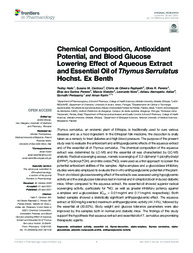Chemical Composition, Antioxidant Potential, and Blood Glucose Lowering Effect of Aqueous Extract and Essential Oil of Thymus Serrulatus Hochst. Ex Benth.
Chemical Composition, Antioxidant Potential, and Blood Glucose Lowering Effect of Aqueous Extract and Essential Oil of Thymus Serrulatus Hochst. Ex Benth.
Author(s): HAILE, T.; CARDOSO, S. M.; RAPHAELLI, C. de O.; PEREIRA, O. R.; PEREIRA, E. dos S.; VIZZOTTO, M.; NORA, L.; ASFAW, A. A.; PERIASAMY, G.; KARIM, A.
Summary: Thymus serrulatus, an endemic plant of Ethiopia, is traditionally used to cure various diseases and as a food ingredient. In the Ethiopian folk medicine, the decoction is orally taken as a remedy to treat diabetes and high blood pressure. The purpose of the present study was to evaluate the antioxidant and antihyperglycemic effects of the aqueous extract and of the essential oil of Thymus serrulatus. The chemical composition of the aqueous extract was determined by LC-MS and the essential oil was characterized by GC-MS analysis. Radical scavenging assays, namely scavenging of 2,2-diphenyl-1-picrylhydrazyl (DPPH?), hydroxyl (?OH), and nitric oxide (?NO), were used as a first approach to screen the potential antioxidant abilities of the samples. Alpha-amylase and α-glucosidase inhibitory studies were also employed to evaluate the in vitro antihyperglycemic potential of the plant. The in vivo blood glucose lowering effect of the extracts was assessed using hypoglycemic activity and the oral glucose tolerance test in normal and in streptozotocin induced diabetic mice. When compared to the aqueous extract, the essential oil showed superior radical scavenging activity, particularly for ?NO, as well as greater inhibitory potency against α-amylase and α-glucosidase (IC50 0.01 mg/ml and 0.11 mg/ml, respectively). Both tested samples showed a statistically significant antihyperglycemic effect. The aqueous extract at 600 mg/kg exerted maximum antihyperglycemic activity (44.14%), followed by the essential oil (30.82%). Body weight and glucose tolerance parameters were also improved by the samples both in normal and diabetic mice. The findings of this study support the hypothesis that aqueous extract and essential oil of T. serrulatus are promising therapeutic agents.
Publication year: 2021
Types of publication: Journal article
Keywords: Antioxidante, Extrato, Extrato Vegetal, Thymus serrulatus, Óleo Essencial
Observation
Some of Embrapa's publications are published as ePub files. To read them, use or download one of the following free software options to your computer or mobile device. Android: Google Play Books; IOS: iBooks; Windows and Linux: Calibre.
Access other publications
Access the Agricultural Research Database (BDPA) to consult Embrapa's full library collection and records.
Visit Embrapa Bookstore to purchase books and other publications sold by Embrapa.

